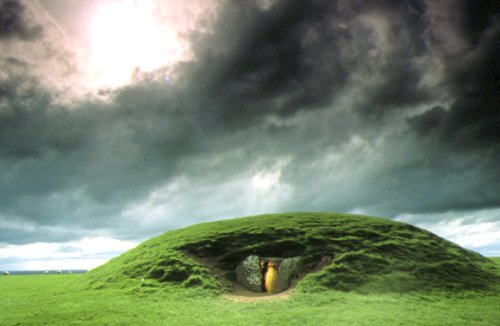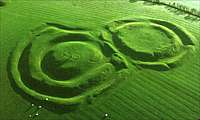"The Hill of Tara has a strange effect on people. From up here on the heights one sees not only into the distance, but into Tara's past. Tara has more than its share of heady stories to tell - tales of intoxicating drinks and chariot-driving High Kings. There are old hags who transform themselves into beautiful women and singing blocks of stone which announce the presence of future kings. Tara is imbued with a magical, mythical atmosphere. It is the stuff of legends, the home of gods and heroes, not mere mortals. At the Hill of Tara, Irish myth, legend and history are one - this magical site has been home to gods and goddesses, to druids and warriors, and to Ireland's High Kings." - Meath Tourism

The Hill of Tara, situated in County Meath has been a sacred site throughout 4000 years history of Ireland. It is a sanctuary where Celtic people should come back to at their times of prosperity or sufferings. In Irish myth and legend, god-kings of the Tuatha Dé Danann, such as Bres and Nuadu, reigned here. Ruins and remains excavated at and around Tara have given possibly evidences of mythological royal seat.
Celtic people in ancient times avoided holding hereditary dynasties. They backed up their own tribal kings, and the most virtuous king was chosen as the High King, the representative of all Irish tribes. It was at Tara that the legendary Bull-Sleep took place to choose the rightful king-elect; and the Stone of Fál, a magic stone which cried aloud when touched by the rightful king. So the one who was loved and chosen by Celtic gods and people at Tara was dignified and called the King of Tara.
Tara was in ancient times a centre of politics and religion of Ireland, moreover a capital of celebration. Here the successive Kings of Tara held the great banquets, and all status and professions, such as chieftains, poets, lawgivers, holy men and entertainers, came up and were responsible for the preservation of classical tradition and learning of foreign cultures. They also built up the ancient paths and tracks to Tara, and the tradition of Irish hospitality. The paths and tracks that lead to Tara are many and varied, as indeed are the trails and routes to Japanese ancient capital Kyoto, which is also a cosmopolitan city today.
Tara is also the site of a Passage Tomb known as the Mound of the Hostages which was built about 2,500
B.C. The oval mound at Balgeeth, Ardcath has not been excavated. The
mound measures 12 metres north-south and 9 metres east-west. The mound
is situated on a ridge between Newgrange to the North and Fourknocks
to the East.
Tomb known as the Mound of the Hostages which was built about 2,500
B.C. The oval mound at Balgeeth, Ardcath has not been excavated. The
mound measures 12 metres north-south and 9 metres east-west. The mound
is situated on a ridge between Newgrange to the North and Fourknocks
to the East.
St Patrick and his followers decided to celebrate Easter near Tara, because it was the greatest kingdom among the Irish tribes which practised idolatry. The pagan tribes held a fire feast on the same night as Patrick intended to celebrate Easter. The pagan custom forbade anybody lighting a fire before a fire was visible in the palace of Tara. Patrick lit the paschal fire on the plain below the palace. The fire was observed from the Hill of Tara and the druid told the enraged king Loegaire that unless the offending fire was extinguished that same night, it would never be put out. A contest between Patrick and the druids ensued, the druids inveighed Patrick to work miracles. The druids' miracles were malevolent, causing unnatural storms of thunder and snow. Patrick was able to undo their evil. One druid attempted to work a miracle using fire but his burnt to death. King Loegaire was enraged by the death of the druid but he did not attack Patrick. Reluctantly, the king and his followers converted to Christianity.
The Tara Brooch was found at Bettystown in 1850. Often copied in modern jewelry designs, the brooch is one of Ireland's finest pieces of early Christian gold-filigree work, embellished with amber and glass. It's on view at the National Museum in Dublin.
